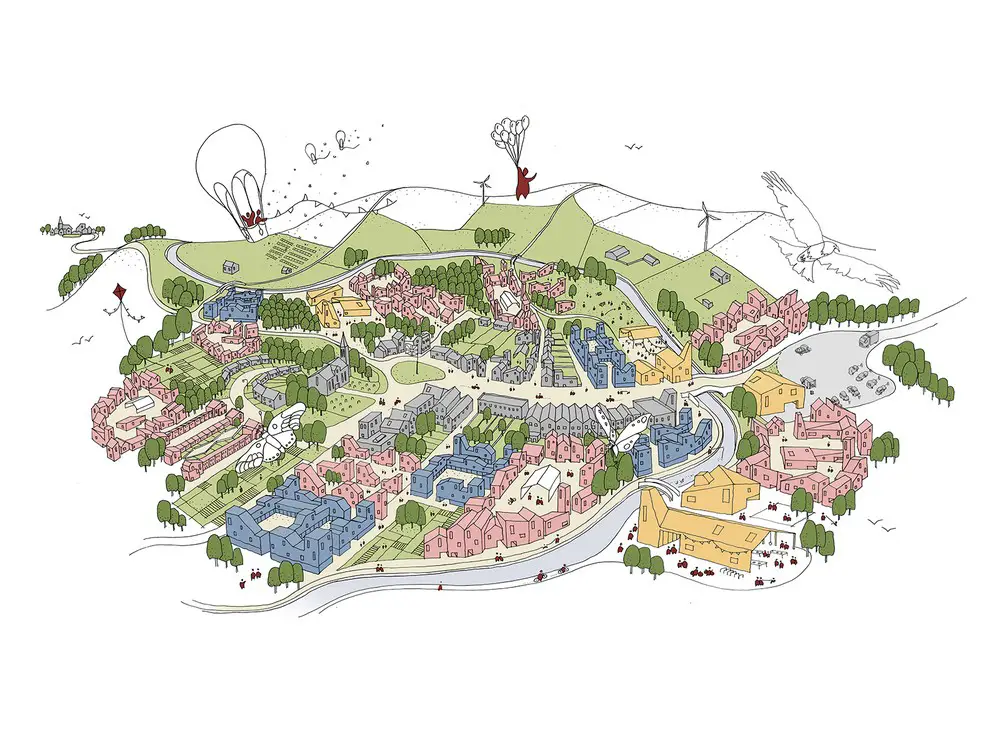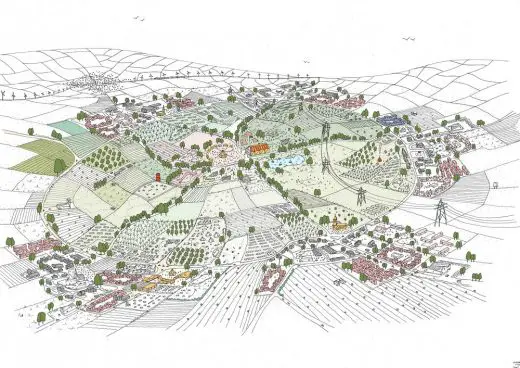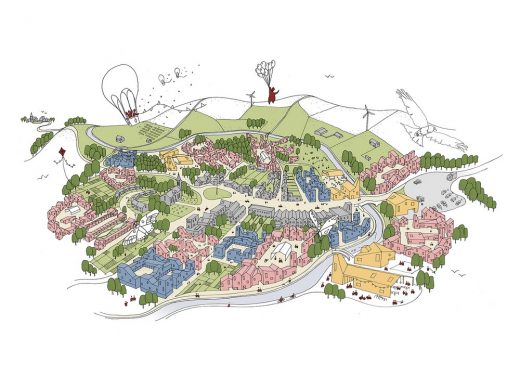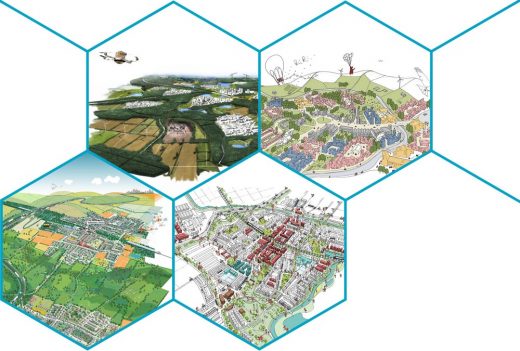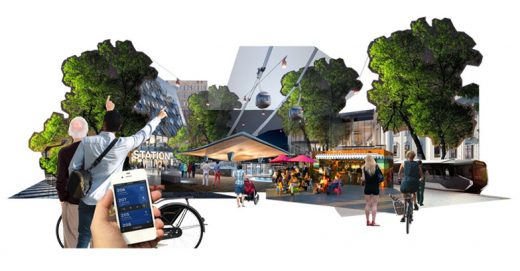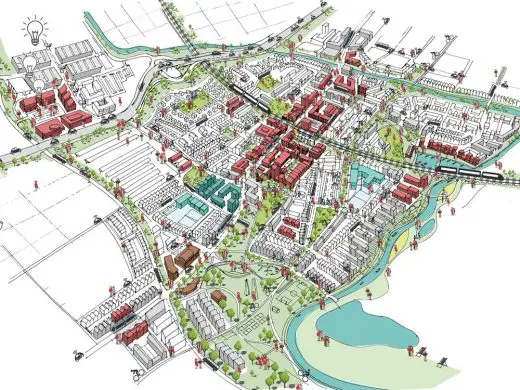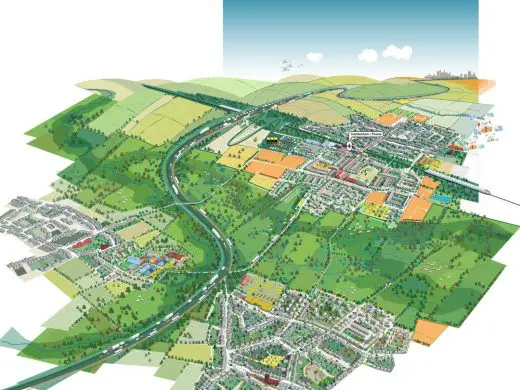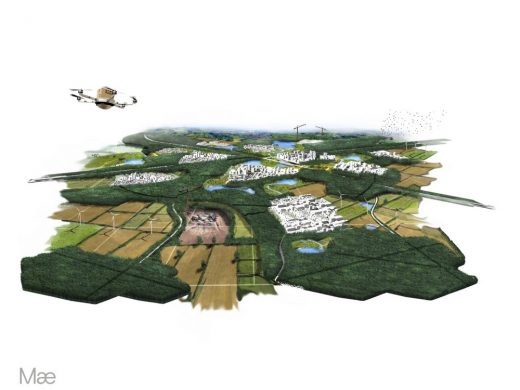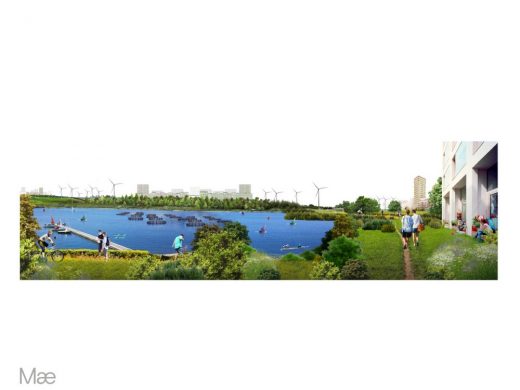Cambridge to Oxford Connection Architecture Competition, UK growth corridor design contest news
Cambridge to Oxford Connection Competition
English Architecture Contest, UK: link new infrastructure with sustainable placemaking in growth corridor
post updated 18 January 2025
VeloCity: Oxford to Cambridge Regional Corridor
IMCL 2018 Honor Award: Proposed Project: VeloCity: Oxford to Cambridge Regional Corridor
Planner: Tibbalds Planning and Urban Design, London, England, UK
Client: National Infrastructure Commission, UKP
22 Jun 2018
Cambridge to Oxford Regional Corridor
Jury Statement:
This is a visionary conceptual plan, directly and clearly illustrating through cartoons how to sustainably accommodate one million new homes across a swath of English countryside stretching from Oxford to Milton Keynes to Cambridge.
This vision soundly rejects auto-dependent sprawl in favor of bike and pedestrian networks, and imagines the revival of existing villages and small towns not as retirement centers so prevalent today, but as vibrantly growing hubs for young families living a sustainable lifestyle.
VeloCity makes a powerful statement about the importance of maintaining character of place while accommodating infill growth. To help communities choreograph their own village development, the plan proposes a strategic approach to planning and suggests design codes. A variety of two- to four-story clustered terrace houses, flats, co-housing, and live/work sheds are recommended, built to passive solar standards.
New strategic cycling routes encourage active transportation. At the heart of each village is an emphasis on maintaining green open space for social exchange, productive gardens, and agriculture. The project shows how young families can be attracted to dying villages by the promise of a healthier, more active lifestyle.
There is a centuries-old tradition of pedestrian rights of way that create a fine web across England, linking villages and towns originally spaced a comfortable day’s walk from each other. This is the kind of network that is now envisioned by maximizing bicycle access across this area.
This inspirational project offers an exemplary model for future development, that because of its small scale approach is inherently deliverable. The jury wishes the interdisciplinary VeloCity team – an outstanding women-led collaborative effort involving six firms – great success in working with the National Infrastructure Commission to make these ideas and strategies a reality.
6 Dec 2017
Cambridge to Oxford Connection Competition Winners
National Infrastructure Commission announces winner of The Cambridge to Oxford Connection: Ideas Competition
6th December 2017 – The National Infrastructure Commission (NIC) and Malcolm Reading Consultants (MRC) today announced the ‘VeloCity’ team led by Tibbalds Planning and Urban Design as winners of The Cambridge to Oxford Connection: Ideas Competition.
Their vision was chosen for its low-impact blueprint for delivering much-needed new homes while maintaining a person-centred scale and retaining the existing character of the area.
The all-women ‘VeloCity’ team included Jennifer Ross from Tibbalds, along with Sarah Featherstone (Featherstone Young), Kay Hughes (Khaa), Petra Marko (Marko and Placemakers), Annalie Riches (Mikhail Riches) and Judith Sykes (Expedition Engineering).
The competition sought inspirational visions for the future of development within the arc encompassing Cambridge, Milton Keynes, Northampton and Oxford, one of the UK’s fastest-growing and most productive regions. It informed the NIC’s report Partnering for Prosperity: A new deal for the Cambridge-Milton Keynes-Oxford Arc, published last month.
In the Budget, the Government backed the Commission’s vision to build up to one million new homes across the arc by 2050, and announced plans to complete both a new East-West Rail link and an Oxford-Cambridge Expressway by 2030.
The Commission will showcase the winner’s and finalists’ work along with all earlier submissions at a conference and related public exhibition in early 2018.
Bridget Rosewell, Commissioner and competition jury Chair, said:
“The jury was drawn to VeloCity’s human scale approach to sensitively and incrementally accommodating new homes, alongside the team’s commitment to ensuring new settlements would be communities from the get-go. Creating effective new settlements can be challenging: the team’s flair and imagination in addressing this shows how good design can translate into liveable communities.”
Lord Andrew Adonis, National Infrastructure Commission Chair and competition jury member, said:
“The competition focused on essential challenges facing the UK, including how to accelerate the supply of affordable homes without sacrificing the quality of the environment, how to engage and enthuse the public in making the choices ahead, and to showcase how new infrastructure can creatively enable new communities to flourish over the coming decades.
“The visions and imagery generated by the competition are tools that will inspire a new approach to achieving sensitive, infrastructure-enabled development over the next half century.”
Jennifer Ross, VeloCity team leader, said:
“We’re absolutely thrilled to win. The six of us met taking part in women’s cycling events and became friends through a shared interest in designing places that put the pedestrian and cyclist first. We wanted to work together and the competition was the perfect opportunity. We spent a lot of time discussing density and place-making and how the implementation of new public transport infrastructure can change the way we plan for and think about building successful communities.”
Malcolm Reading, Competition Organiser, said:
“We would like to thank everyone who followed and entered the competition and, in particular, the four finalists who all worked extremely hard. This was the first ideas competition we’ve run and it was hugely exciting to see the contribution made by the design profession to national issues that have profound implications for future generations.”
Key features of the winning vision include:
-generously-sized common land at the heart of each development providing a focus for encouraging communities to interact and shared amenities
-integrated public transport connections with expanded pedestrian and cycle routes, limiting the need for car use
-small-scale construction and local utility networks designed to reduce the environmental impact of new housing
Clustered around six villages south-east of a new station on the Oxford to Cambridge rail link, VeloCity’s vision could be replicated across the arc to support a substantial number of new homes.
The Commission launched the two-stage competition in June, and received 58 first-stage submissions from multidisciplinary teams including urban designers; architects; planners; landscape designers and economists.
The jury invited four teams led by Barton Willmore, Fletcher Priest Architects, Mae, and Tibbalds Planning and Urban Design to produce detailed strategies for integrating infrastructure with placemaking in the Cambridge – Milton Keynes – Oxford arc.
The jury interviewed the shortlisted teams and selected the VeloCity team as winners. The four finalists each receive an honorarium of £10,000.
The Cambridge – Milton Keynes – Oxford arc is home to 3.3 million people. The region hosts some of the country’s most successful universities and high-tech manufacturing hubs and has a highly-skilled workforce. Its future success is threatened by significant housing constraints and transport pressures. The Commission’s report identified how well-designed and planned infrastructure could enable authorities across the region to overcome them and ensure the region’s long-term prosperity.
The shortlisted teams:
Barton Willmore with Momentum
Fletcher Priest Architects with Bradley Murphy Design and Peter Brett Associates
Mae with Oneworks, Planit, AKT II, Tyrens and Max Fordham
Tibbalds Planning and Urban Design with Mikhail Riches, Featherstone Young, Marko and Placemakers, Expedition Engineering & Khaa
The shortlisted entries are available to view in the competition’s online gallery.
The competition jury:
The full jury for The Cambridge to Oxford Connection: Ideas Competition comprised:
Bridget Rosewell OBE FICE (Jury Chair), Co-Founder, Volterra Partners and Commissioner, National Infrastructure Commission
David Lock CBE MRTPI, Strategic Planning Adviser, David Lock Associates
Georgia Butina Watson BA MA PhD FRSA, Professor and Research Director of Urban Design, Oxford Brookes University
Hilary Chipping, Deputy Chief Executive and Head of Strategy and Operations, Southeast Midlands Local Enterprise Partnership
Lord Andrew Adonis, Chairman, National Infrastructure Commission
Sadie Morgan D.Des (LSBU) FRSA, Founding Director, dRMM Architects and Commissioner, National Infrastructure Commission
Tim Broyd FREng CEng FICE FRSA, Professor of Built Environment Foresight and Honorary Professor of Civil Engineering, University College London
Tom Holbrook, Director, 5th Studio and Professor of Architecture and Industry Fellow, RMIT University
15 Oct 2017
Cambridge to Oxford Connection Competition Design Concepts
National Infrastructure Commission announces design concepts by shortlisted teams for The Cambridge to Oxford Connection: Ideas Competition
The National Infrastructure Commission and Malcolm Reading Consultants have revealed the four final design concepts: The Cambridge to Oxford Connection: Ideas Competition online gallery.
Launched in June, the competition sought inspirational yet achievable visions for future development of this key economic area, covering Cambridge, Milton Keynes, Northampton and Oxford. Finalists focused on integrating infrastructure and development to create sustainable and liveable places appropriate to the corridor.
Finalists’ ideas for enhancing the corridor include a new National Park; an archipelago of linked, distinctive and compact places; a series of ecologically-rich urban campuses; and a reimagining of the 21st-century village.
From today, the four finalists’ strategic design concepts for development growth will be showcased in a digital gallery:Cambridge to Oxford Connection Competition Shortlist.
There is also an opportunity to submit comments on each scheme proposed, at [email protected]
The four shortlisted teams – led by Barton Willmore, Fletcher Priest Architects, Mae, and Tibbalds Planning and Urban Design – were selected by a jury of thought-leaders in infrastructure, economics, design and placemaking, and announced in August.
The winner of the design competition is expected to be announced in November 2017.
For the teams’ full concept summaries, please see the Notes to Editors. In brief, their key themes (in alphabetical order by team lead name) are:
- Barton Willmore developed The CaMKoX Innovation Hive Delivery Guide – not a fixed masterplan but an approach that envisages organic growth within communities, delivering not just homes but vibrant places to support innovation and business creation. A carefully guided approach to encourage communities to acquire a rich urban form and varied sense of place. Situated within a new National Park, the proposals set a new benchmark for development that enhances the natural environment.
- Fletcher Priest Architects developed the Mid-Vale Archipelago, a constellation of linked, distinctive and compact places set within a continuous landscape. They propose ‘middle sites’ between the corridor’s major urban centres that combine the best of village life with the critical mass of larger towns while preserving and enhancing landscape character. The desire for beneficial relationships between existing and new communities is central – along with a patient approach to delivery that prioritises long-term capital benefits over short-term windfall returns.
- Mae developed Urcadia – an ecologically rich urban settlement for the Just About Managing, the Yes-in-my-back-yards, the Millennials, and Generation Rent in the form of a ‘New Living Campus’. Their proposal combines the intensity and density of a city with the pastoral richness of the English countryside enhanced for leisure use, health and well-being and food production. New construction technologies facilitate economic housing for a generation suffering from no realistic prospect of owning a home.
- Tibbalds Planning & Urban Design developed VeloCity, a unique region in the UK that is no longer reliant on the car, supported by an integrated road-and-rail transport strategy linked to a network of local, medium and longer distance cycle routes. Focusing on six villages situated to the south-east of one of the new stations on the Oxford to Cambridge rail link, VeloCity reimagines the 21st-century village.
Commissioner for the National Infrastructure Commission and competition jury chair Bridget Rosewell, said:
“The corridor encompassing Cambridge, Milton Keynes, Northampton and Oxford contributes considerably to our national economy – if we’re to continue this success we must foster places people want, and can afford, to live and work in.
“The four shortlisted entries to our ideas competition are creative, innovative and exciting. This online gallery gives people the chance to see these entries, and to have a say on how their area could be developed in future.
“I’m delighted that we’ve attracted so much attention from leading lights across design, architecture, economics and town planning, and that residents and the industry at large will now get to see what their collective talents have proposed.”
Competition organiser Malcolm Reading, said:
“These are four very diverse proposals that propel us deep into the 21st century. They show that it is possible to be imaginative in responding to a raft of competing challenges and are an urgent reminder that we do need a plan and a strategy or we will be overtaken by the times – losing out economically, in terms of quality of life, or both.
“We’re delighted that this ideas competition has generated a new set of possibilities that contribute to the wider debate of how we, as a nation, want to ‘design’ our future.”
About The Cambridge to Oxford Connection: Ideas Competition
A total of 58 teams from the UK and further afield entered the competition’s first stage, anonymously submitting ideas based on a chosen form of development – ranging from the intensification of existing urban areas to new autonomous settlements – along with separate details on their teams.
The Cambridge – Milton Keynes – Oxford corridor stretches over approximately 130 miles around the north and west of London’s Green Belt, encompassing Daventry and Wellingborough to the north and bounded to the south by Luton, Stevenage and the Aylesbury Vale.
While the corridor includes some of the country’s most successful cities, as well as world-leading universities, high tech firms and highly skilled workers, it does not function as a single joined-up economic zone.
The National Infrastructure Commission has recommended that the government implements the next phase of the highly-anticipated East West Rail project and the planned Oxford to Cambridge Expressway, both of which are set to transform connectivity within this part of England.
The ideas competition is a key part of that work, and encouraged urban designers, architects, planners, policy and community specialists, landscape designers and development economists to come forward and submit their designs for how the corridor could be developed in the future.
In November, the National Infrastructure Commission will announce the overall winning entry for the competition, and publish its final report and recommendations for further supporting the growth corridor.
The four finalists’ proposals from The Cambridge to Oxford Connection: Ideas Competition – fully credited to the competitors – will be published alongside the Commission’s Final Report.
+++
22 Aug 2017
Cambridge to Oxford Connection Competition Shortlist
National Infrastructure Commission announces shortlist for The Cambridge to Oxford Connection: Ideas Competition
• This two-stage competition focuses on integrating placemaking with infrastructure in one of the UK’s leading growth regions
• Four multi-disciplinary teams will now develop detailed concepts appropriate for the Cambridge – Milton Keynes – Oxford corridor
• Shortlist features creative collaborations and a mixture of established and emerging talent
• Jury of thought-leaders in infrastructure, economics, design and placemaking selected four finalists and awarded two honourable mentions from 58 concepts submitted anonymously at Stage One

image courtesy of Alamy Stock Photo, individual credits as follows (left to right, top to bottom): Dave Porter, Robert Stainforth, Julian Eales, Mark Pink, A.P.S. (UK), Cultura Creative (RF), Robert Stainforth, geophoto, Chris Deeney, David CC.
The National Infrastructure Commission and Malcolm Reading Consultants today (22 August 2017) announced the shortlist for The Cambridge to Oxford Connection: Ideas Competition. This two-stage competition is seeking inspirational yet realisable visions for the future of development within the arc encompassing four of the UK’s fastest-growing and most productive centres: Cambridge, Milton Keynes, Northampton and Oxford.
The free-to-enter competition launched on 30 June 2017 and invited entries from broad multidisciplinary teams made up of urban designers; architects; planning, policy and community specialists; landscape designers; development economists; and others with local knowledge and general insight. Fifty-eight teams from the UK and further afield entered at the first stage, anonymously submitting emerging concepts focused on a chosen form of development – ranging from the intensification of existing urban areas to new autonomous settlements – along with separate details on the composition of their team.
The high-profile jury of thought-leaders in infrastructure, economics, design and placemaking, chaired by Bridget Rosewell (Commissioner for the National Infrastructure Commission), judged the emerging concepts and team composition and selected a shortlist.
The four shortlisted teams – all UK-based – feature creative, multi-disciplinary collaborations and a mixture of established practices and emerging talent. The shortlisted teams were led by the following practices (in alphabetical order):
• Barton Willmore
• Fletcher Priest Architects
• Mae
• Tibbalds Planning and Urban Design
The jury also wished to convey its appreciation for the distinctive thinking evident in a further two submissions, and honourable mentions were awarded to the teams led by:
• O&H Properties
• OMMX
The shortlisted teams will each receive an honorarium of £10,000 to develop their initial first-stage submissions into design concepts for development typologies appropriate to the corridor. They will be asked to consider existing, planned or proposed infrastructure and how to integrate this with development to create sustainable and liveable places.
The competition jury will meet again in October to review the second-stage submissions, interview the shortlist and select a winner of the competition. The winner is expected to be announced in early November.
Bridget Rosewell, Commissioner for the National Infrastructure Commission and Competition Jury Chair, said:
‘The Commission and the jury were delighted with the quality and detail of submissions to the competition, and we would like to thank all those who offered their ideas and energies. The shortlisted teams produced particularly imaginative and stimulating responses to the first-stage brief and we look forward to seeing how their ideas and visions develop.
‘At the second stage, we will be looking for proposals that are rooted in their context and understand the local character, environment and landscape. We have asked competitors to consider how places will be integrated with infrastructure, but above all, we want to see what the proposals will mean for the lives of the people living and working in the corridor.’
Lord Andrew Adonis, Chair of the National Infrastructure Commission and Competition Jury Member, added:
‘Getting development right in the Cambridge – Milton Keynes – Oxford corridor is vital for prosperity in the region and the UK at large. In order to maintain and build on the area’s economic success, we need to foster attractive and well-connected places that people want to live in.
‘The challenge is urgent, but the 58 submissions to our ideas competition have shown there is a wealth of innovative thinking out there. This initiative has clearly resonated with a wide range of people, and will continue to do so as we enter the competition’s
second stage.’
Malcolm Reading, Competition Organiser, said:
‘The Cambridge – Milton Keynes – Oxford corridor is one of the fastest-growing and productive regions of the UK, but there are also significant pressures – on housing, transport, connectivity, and much else – which call for imaginative, forward-thinking
solutions from a broad spectrum of expertise.
‘In throwing open this opportunity to the widest range of talent, the National Infrastructure Commission has secured a diverse shortlist and demonstrated its openness to new thinking from practices with different perspectives within the design community.’
The Cambridge – Milton Keynes – Oxford corridor stretches over approximately 130 miles around the north and west of London’s green belt, encompassing Daventry and Wellingborough to the north and bounded to the south by Luton, Stevenage and the Aylesbury Vale. The region is home to 3.3 million people and hosts some of the country’s most successful cities, as well as world-leading universities, knowledge-intensive high-tech firms and highly-skilled workers. Altogether, an estimated 419,000 people across the corridor are employed in the knowledge economy.
Presently, the corridor does not function as a single joined-up economic zone. Rather Cambridge, Milton Keynes, Northampton and Oxford operate as distinct city economies, each positioned on different radial routes around 50-70 miles from London. The area is experiencing significant housing and transport pressures: the scarcity of suitable and affordable homes and difficulties in travelling within and between cities. These constraints are becoming obstacles to attracting and retaining talent and inevitably putting a break on economic growth.
The National Infrastructure Commission – as the United Kingdom’s leading independent voice on infrastructure policy and strategy and a key adviser to government – has recommended that the government implements the next phase of the highly-anticipated East West Rail project and the planned Oxford to Cambridge Expressway, both of which are set to transform connectivity within this part of England.
A Final Report from the Commission to government in late 2017 will present its findings on maximising the potential of the Cambridge – Milton Keynes – Oxford corridor as a single, knowledge-intensive cluster. The four finalists’ proposals from The Cambridge to Oxford Connection: Ideas Competition – fully credited to the competitors – will be published alongside the Commission’s Final Report.
+++
Cambridge to Oxford Connection Competition Shortlisted Teams
Cambridge to Oxford Connection Competition Shortlisted Team Details
Shortlist
• Barton Willmore – Robin Shepherd (Planning Partner); John Haxworth (Partner); Dominic Scott (Urban Design Partner); Gareth Wilson (Planning Partner); Michael Knott (Planning Director); Ben Lewis (Infrastructure Director); Peter Newton (Architecture Director); Carolyn Organ (Planning Associate); Vaughan Anderson (Urban Design Associate); Patrick Clarke (Associate Landscape Planner); Richard Webb (Associate Landscape Architect); Simone Gobber (Urban Designer); and Tom Carpen (Infrastructure Associate) – with Will Durden (Director, Momentum)
• Fletcher Priest Architects with Bradley Murphy Design and Ron Henry (Partner, Peter Brett Associates)
• Mae with One Works, AKT II and Planit-IE
• Tibbalds Planning and Urban Design – Jennifer Ross (Director) – with Annalie Riche (Co-Director, Mikhail Riches), Petra Marko (Co-Founder and Director, Marko&Placemakers), Sarah Featherstone (Co-Director, Featherstone Young) and Kay Hughes
Honourable mentions
• O&H Properties Ltd – Pippa Cheetham (Planning Manager) – with David Atherton (Partner, Peter Brett Associates), Bill Gush (Regional Director, Land & Water Group), James Russell (Chartered Environmentalist and Chartered Forester, Forest of Marston Vale Trust), Espen Østbye-Strøm (Chief Operating Officer, Floodline Developments), Simon Collier (Partner, David Lock Associates), James Clifton (Architect and Planner, Canal and River Trust), Jane Hamilton (Chair, Bedford and Milton Keynes Waterway Trust) and Gareth Barker (Anglian Water)
• OMMX – Hikaru Nissanke (Director) and Jon Lopez (Director) – with Paul Toplis (Partner, Price & Myers)
+++
25 Jul 2017
Cambridge to Oxford Connection Competition Jury
The Oxford to Cambridge Connection – jury announced
This design contest for the National Infrastructure Commission has just announced the competition jury.
It is chaired by Bridget Rosewell, and features Lord Andrew Adonis, Sadie Morgan, David Lock, Tom Holbrook and others. The full list with short biographies can be seen here.
Bridget Rosewell OBE FICE (Jury Chair)
Co-Founder, Volterra Partners and Commissioner, National Infrastructure Commission
David Lock CBE MRTPI
Strategic Planning Adviser, David Lock Associates
Georgia Butina Watson BA MA PhD FRSA
Professor and Research Director of Urban Design, Oxford Brookes University
Hilary Chipping
Deputy Chief Executive and Head of Strategy and Operations, Southeast Midlands Local Enterprise Partnership
Lord Andrew Adonis
Chairman, National Infrastructure Commission
Sadie Morgan D.Des (LSBU) FRSA
Founding Director, dRMM Architects and Commissioner, National Infrastructure Commission
Tim Broyd FREng CEng FICE FRSA
Professor of Built Environment Foresight and Honorary Professor of Civil Engineering, University College London
Tom Holbrook
Director, 5th Studio and Professor of Architecture and Industry Fellow, RMIT University
+++
30 Jun 2017
Cambridge to Oxford Connection Ideas Competition
Cambridge to Oxford Connection Competition
Open call for ideas to creatively link new infrastructure with sustainable placemaking in the UK’s leading growth corridor – deadline 14:00 BST 3 August 2017
THE CAMBRIDGE TO OXFORD CONNECTION: IDEAS COMPETITION LAUNCHES
The National Infrastructure Commission and Malcolm Reading Consultants today (30 June 2017) launched an ideas competition that calls for forward thinking, imaginative proposals to integrate sustainable placemaking with development and new infrastructure. The focus for the competition is the arc encompassing four of the UK’s fastest-growing and most productive centres: Cambridge, Milton Keynes, Northampton and Oxford.
The free-to-enter, two-stage contest is aimed at broad multidisciplinary teams of urban designers; architects; planning, policy, and community specialists; landscape designers; development economists; and others with local knowledge and general insight. Submissions from international teams and students are welcome.
Set up in 2015, the National Infrastructure Commission is the United Kingdom’s leading independent voice on infrastructure policy and strategy, a key adviser to government, and benefits from strong cross-party support. The Commission has recommended that government implements the next phase of the highly anticipated East West Rail project and the planned Oxford to Cambridge Expressway, both of which are set to transform connectivity within this part of England.
Through the competition, the Commission will be seeking visionary ideas for development typologies across the Cambridge – Milton Keynes – Oxford corridor, which includes other important centres such as Northampton. Submissions should consider how to provide the homes the area needs: high quality places that integrate the proposed infrastructure and enhance the identity of the corridor as a single knowledge-intensive cluster, while working with its distinctive environmental and cultural character.
Full details of the competition, which is run by Malcolm Reading Consultants, including team and submission requirements and the detailed brief, are available on the competition website:
Teams are asked to submit an emerging concept focused on a chosen form of development – ranging from the intensification of existing urban areas to new autonomous settlements – as well as details on the composition of their collaborative teams, if relevant. The emerging concepts will be judged anonymously by a panel drawn from a range of specialisms and including Lord Andrew Adonis, Chair of the National Infrastructure Commission; and two National Infrastructure Commissioners, Bridget Rosewell OBE, former Chief Economic Adviser to the Greater London Authority; and Professor Sadie Morgan, Founding Director of dRMM Architects, with further members to be announced later in the process. The top four teams will be given an honorarium of £10,000 to develop their initial submission.
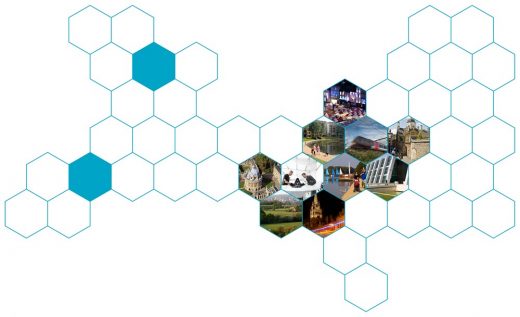
image courtesy of Alamy Stock Photo ; individual credits are (left to right, top to bottom): Dave Porter, Robert Stainforth, Julian Eales, Mark Pink, A.P.S. (UK), Cultura Creative (RF), Robert Stainforth, geophoto, Chris Deeney, David CC.
Lord Adonis, Chair of the National Infrastructure Commission, said:
“The economic potential of the four cities of Oxford, Cambridge, Northampton and Milton Keynes is huge, offering real benefits to the success and prosperity of the country as a whole.
“But the area needs to adapt and change if it has any chance of achieving this, of attracting the brightest and best and of competing on the world stage.
“Today, I’m calling on leaders in architecture, economics, policy-making and planning, as well as local residents, to help shape that future, and put forward ideas that will make this growth corridor an attractive place to live and work for generations to come.”
Professor Sadie Morgan, National Infrastructure Commissioner and Founding Director of dRMM Architects, said:
“From the dreaming spires of Oxford to punts along the River Cam, the growth corridor has so much to offer those looking to live and work there. We need to ensure that continues.
“This is more than just good design – this is about creating a vibrant and attractive community that will stand the test of time and support the future development and prosperity of a unique part of the country. I look forward to seeing the ideas that are put forward.”
Malcolm Reading, Competition Organiser, said:
“Transport brings prosperity and activity and creates the conditions for growth, which are all welcome outcomes. The competition offers a rare opportunity to imagine new and enlarged communities, to shape their character. This is all about creating inspirational places that encourage social and creative exchange within a high quality environment.”
The Cambridge – Milton Keynes – Oxford corridor stretches over approximately 130 miles around the north and west of London’s green belt, encompassing Daventry and Wellingborough to the north and bounded to the south by Luton, Stevenage and the Aylesbury Vale. The area has a population of 3.3 million people and is approximately 3,900 square miles in area.
Towns and cities across the corridor are amongst the most successful and fastest growing in the UK. The corridor has a concentration of businesses in the scientific research and development, life sciences, pharmaceuticals, high-tech manufacturing, performance technology and motorsport sectors. An estimated 419,000 people across the corridor are employed in the knowledge economy. Presently, the corridor does not function as a single joined-up economic zone. Rather Cambridge, Milton Keynes, Northampton and Oxford operate as distinct city economies, each positioned on different radial routes around 50-70 miles from London.
The area is suffering with significant housing and transport pressures: the scarcity of suitable and affordable homes and difficulties in travelling within and between cities. These constraints are becoming obstacles to retaining talent and inevitably putting a break on economic growth.
Interested teams will need to read the Search Statement on the competition website before submitting their emerging concept, team details and registration information via email (using templates provided on the website). The deadline for entries is 14:00 BST 3 August 2017. At the second stage of the competition, four shortlisted teams will receive additional briefing and progress their concepts into creative visions, developed on a specific location within the corridor.
The final designs produced by the shortlist will be used in the Commission’s Report to government in late 2017 and will be fully credited to the authors. The teams may also be given a continuing role as the wider project develops.
The stage two deadline for shortlisted teams is expected to be in late September, and the winner announced in early November.
- National Infrastructure Commission
The National Infrastructure Commission (NIC)’s remit is to become the UK’s most forward-thinking and influential voice on infrastructure policy and strategy.
It is an independent body that enables long-term strategic decision making to build effective and efficient infrastructure for the UK. The NIC was set up on 5 October 2015 and will look at the UK’s future needs for nationally significant infrastructure, help to maintain the UK’s competitiveness amongst the G20 nations and provide greater certainty for investors by taking a long-term approach to the major investment decisions facing the country.
- Cambridge – Milton Keynes – Oxford Growth Corridor Project
In March 2016, the Chancellor of the Exchequer asked the Commission to:
“Make recommendations to maximize the potential of the Cambridge – Milton Keynes – Oxford corridor as a single, knowledge-intensive cluster that competes on the global stage, whilst protecting the area’s high quality environment and securing the homes and jobs the area needs. The commission will look at the priority infrastructure improvements needed and assess the economic case for which investments would generate the most growth.”
In November 2016, the NIC published its interim report on the Cambridge – Milton Keynes – Oxford Corridor. This report concluded that:
“The corridor connecting Cambridge, Milton Keynes and Oxford could be a world renowned centre for science, technology and innovation. But its future success is not guaranteed…
“The corridor faces a chronic undersupply of homes made worse by poor east-west transport connectivity. Two of the least affordable cities in the UK lie within the corridor, and the area as a whole has consistently failed to build the number of homes it needs. That shortage puts sustained growth at risk. It is already increasing costs for businesses and diminishing their ability to attract employees at all levels.
“Investment in infrastructure, including enhanced east-west transport links, can help to address these challenges, but it must be properly aligned with a strategy for new jobs, homes and communities, not developed in isolation. This means local authorities working in partnership, and with government, to plan places, homes and transport together. Current governance mechanisms are not sufficient to deliver the step-change in strategic leadership and collaboration needed.”
For further information please see: https://www.nic.org.uk
- Malcolm Reading Consultants
Malcolm Reading Consultants (MRC) is a strategic consultancy that helps clients to imagine and define contemporary environments, both built and natural. MRC is the leading specialist in devising and managing design competitions internationally. MRC believes in the power of design to create new perceptions and act as an inspiration.
Recent work includes competitions for the Illuminated River Foundation, Science Island (Lithuania), Tintagel Castle Bridge, the Mumbai City Museum and new buildings for New College, Oxford and Homerton College, Cambridge.
MRC is currently advising the British Council for Offices Ideas Competition for the future of workspace, and is working with the British Library to establish the Design Brief for the major northern development of its St. Pancras site.
Website: Malcolm Reading Consultants
Location: Cambridge, England, UK
+++
Cambridge Architecture
Cambridge Architecture Design – chronological list
Cambridge Design Competitions
Feilden Fowles Win Homerton College Competition
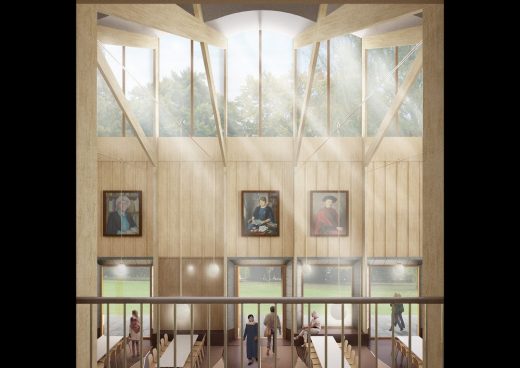
image courtesy of architects
Homerton College Cambridge Design Competition – 22 + 21 Mar 2017
Jesus College Cambridge Architecture Competition

image courtesy of architects
Jesus College Building Cambridge Design Competition – won by Richard Murphy Architects
+++
Oxford Design Competitions
Oxford Station Architecture Competition
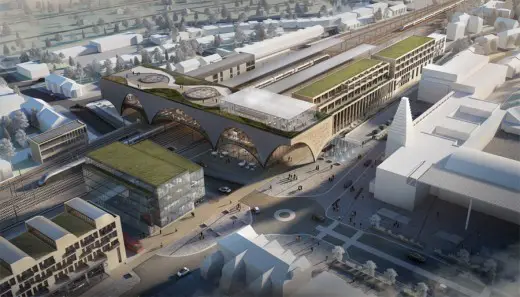
image courtesy of architects
Oxford Station Design Competition
St Hilda’s College, Oxford’s invited design competition
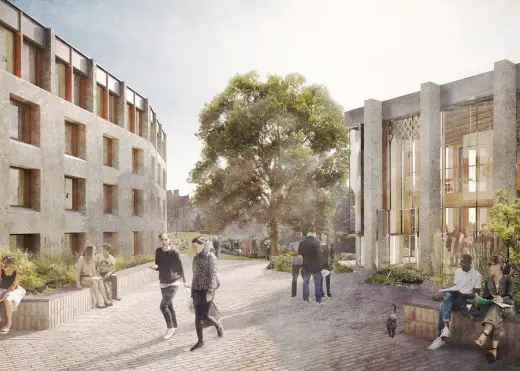
image courtesy of architects
St Hilda’s College Oxford Design Competition – 17 Mar 2016, won by Gort Scott Architects
Design Competition for Renewal of Oxford Modernist Landmark
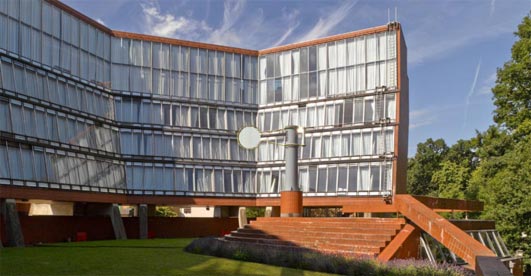
photograph © James Brittain
Florey Design Competition Oxford – 22 Feb 2016 update
Florey Design Competition Oxford Shortlist
Another recent Malcolm Reading Consultants architecture competition on e-architect:
Museum of London West Smithfield Design Competition
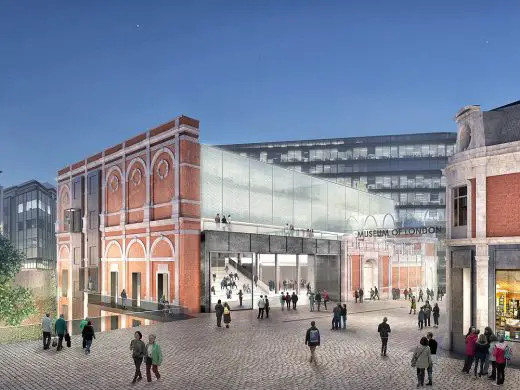
image from architects
Illuminated River International Design Competition
Cambridge Architecture Offices
Homerton College Architecture Competition
Cambridge University Department of Architecture Extension
Design: Mole Architects
Cambridge University School of Architecture
Comments / photos for the Cambridge to Oxford Connection Competition page welcome

